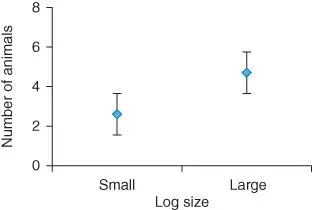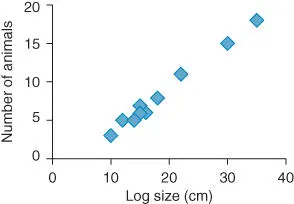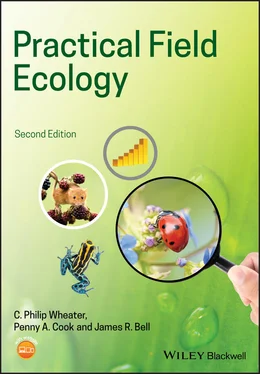Most projects go beyond a simple description of particular species and sites in an attempt to make comparisons or generalisations that can hopefully have wider applicability. For example, if we decide to investigate whether the number of animals found under decaying logs on a woodland floor is influenced by the size of the log, we might approach this in one of three basic ways:
| 1. by looking at possible differences between samples; for example, if the logs were easily divided into two classes (large and small, i.e. <20 cm and ≥20 cm), we could compare the numbers of animals found under each size class; |
 |
| 2. by looking at possible relationships between variables; for example, we might have a wide range of sizes of logs and decide to examine whether the number of animals varies in some systematic way (either increasing or decreasing) as log size increases; |
 |
| 3. by looking at possible associations between frequency distributions; for example, we could compare the frequency of predators, herbivores, decomposers, etc. from under each of two size classes of logs (i.e. <20 cm and ≥20 cm). |
 |
From this simple example it can be seen that how we ask the question has an impact on how we design our study. The three different ways of looking at this study (listed above) also illustrate three broad (basic) types of statistical questions: differences, relationships, and associations between frequency distributions. We will examine each type of question in a little more detail later in this chapter (p. 36), whilst the analytical techniques needed to answer these questions are described in Chapter 5. Other questions that might be asked include: looking at the similarity of sites based on their species composition (i.e. are the animals found under logs from different tree species similar in species composition to each other?); or predicting the presence or numbers of a species from a knowledge of the environmental conditions (e.g. is the presence of wood ants' nests predictable if we know the woodland type, topography, microclimate, etc.?).
By careful design, we strive to ensure that our study does not produce ambiguous results. For example, in a comparison of the invertebrate diversity between urban ponds and rural ponds we could aim to include the size of each pond studied into the survey design. If we did not manage this, and found that the rural ponds surveyed happened to be both larger and contain more invertebrates, it would not be clear whether the results were due to rural ponds being more diverse or whether it was simply an effect of pond size. The correct experimental design would be to either standardise on a given pond size for both environments, or make sure that the full range of pond sizes was included in both environments. Pond size would then be measured, recorded, and built into the subsequent analysis: pond size is then an example of a ‘covariate’. Other factors that would have to be standardised, or at least recognised as covariates, in this particular study would be the quality of the water, the pH, age of pond, and so on.
The goal of the study may be to get a deeper understanding of the system by gathering a wide range of variables. In the pond survey example, this might mean that in addition to pond size, we should take various measures of water quality and chemistry (nutrient status, oxygen content, pH, etc.) and the numbers of each species of plant and animal. For a given number of ponds, there may be a large number of variables giving rise to a complex datasheet. In this example, each pond would have its own row in a spreadsheet, and each variable (e.g. size, pH, number of species) would be a column. In order to examine and make sense of such a complex data set, we would need to move into the realm of multivariate analysis (see Chapter 5).
Designing and setting up experiments and surveys
There are two main approaches to collecting field data: experiments and surveys. An experiment involves the manipulation of a system, whilst a survey depends on observations being taken without manipulation. For example, if we were interested in how many invertebrates could be found under logs of varying size, we could either survey a woodland floor finding as many logs as possible and recording both the number of invertebrates and the size of the log, or we could devise an experiment where we placed logs of differing sizes on a woodland floor and after a period of time examined the number of invertebrates underneath them. The advantage of the experimental approach would be that we could standardise all aspects of the logs except for size; for example, age, the degree of decay, the type of wood, and the distance between logs. All of these factors may influence the invertebrates found and confuse any relationship with log size. However, with a survey we would get an impression of what was happening in a real‐life situation (i.e. under logs that had been naturally deposited). Moreover, we may decide that the experimental approach is damaging to the environment; here, artificially placing logs in a natural system. In addition, for practical reasons, we might decide that the colonisation of newly introduced logs by invertebrates would take longer than the time available for the project to be completed. In most environmental research programmes, surveys are useful for generating ideas about important factors, but because of the additional complexity in real situations, surveys cannot identify cause and effect. Because experiments strip away the additional complexity, they are more useful in identifying cause and effect, but less likely to be applicable to real‐life situations.
When designing experiments, it is important that as many factors as possible are kept constant. So, for example, if we are interested in identifying whether an increase in insecticide concentration will lead to a decrease in aphid infestation of a crop, then the same amount of water (assuming this is the solvent or carrier for the pesticide) should be used for each application (irrespective of the concentration applied) so that we are testing the amount of pesticide added, rather than the amount of water added. In addition, it is important, where possible, to include a control treatment. In this example we would use a water only treatment to see if the addition of any water had an impact. If we did not do this and found a reduction in aphid numbers with any application of pesticide, we would be unable to tell whether this was due to the pesticide or the fluid added.
Choosing sampling methods
The choice of sampling method will usually be dependent upon the habitat type and organisms being studied (see Chapters 2– 4). However, all sampling techniques have limitations, and there are some general principles that are applicable to most sampling methods, for example:
Some techniques may be suitable for a limited range of habitats, or be biased in favour of active rather than sedentary animals, or collect only a subset of the population being examined (e.g. males rather than females, or those migrating rather than those resident). It is therefore very important that limitations are known and accounted for during the design of the research to avoid later problems in interpretation.
Читать дальше















